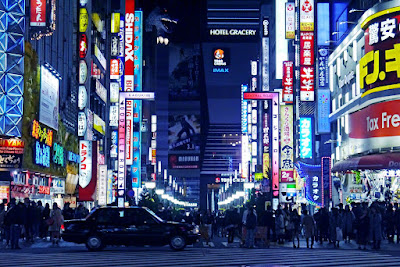 |
| Charming night at Shinjuku |
 |
| The entrance of that bar called me in |
 |
| People party to feel free |
 |
| Charming night at Shinjuku |
 |
| The entrance of that bar called me in |
 |
| People party to feel free |
Japan is a great place to live but is a completely different living experience from anything that you are used to back home. There are a lot of things here in Japan that you will find totally different from your home country. For example, no trash cans in public places, super early last trains (tough when you want to go out for dinner or a drink or two), and banks closing at three in the afternoon.
Don’t be afraid of these differences but embrace them and your new life in Japan.
 |
| "Japan Trains" by shibuya246 is marked with CC BY-NC 2.0. |
Japan is a country that lives and functions by rules and everyone obeying them. Group harmony is more important than any one individual. Some of these rules can seem excessive or overboard but need to be followed in order to get anything done. These rules can be found in basic things in everyday life. For example, simply ordering a hamburger at McDonalds. I once wanted to order a Big Mac without any pickles and an extra serving of cheese. This really threw the poor girl serving me into confusion and panic with alarm bells going off in the restaurant. The restaurant manager was soon on hand, profusely apologizing for not being able to customize my meal. In Japan, A Big Mac is a Big Mac!
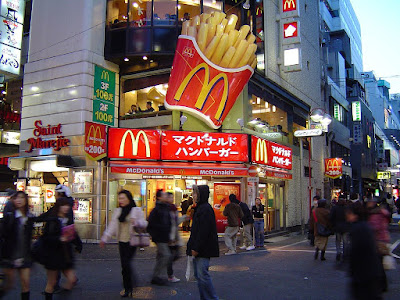 |
| "McDonalds" by Stephen Cannon is marked with CC BY-NC-SA 2.0. |
One thing that really surprised me when I first arrived in Japan was how little English was spoken outside of the major cities and tourist areas. Most Japanese only speak Japanese and very few are willing or capable of speaking English. This has been getting slightly better in recent years, especially with the Tokyo 2020 Olympics happening last year. If you are planning to live in a more rural location or even just outside of a big city, it is definitely a good idea to learn some of the language. For work, most companies will require that you have at least basic Japanese skills in order to work effectively and communicate with your Japanese co-workers. English speaking jobs in Japan can be found in most of the major cities such as Tokyo and Osaka.
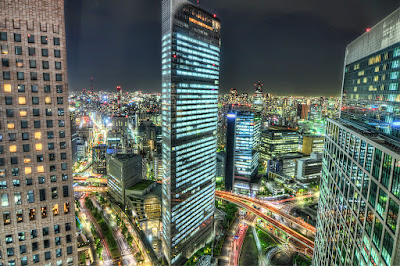 |
| "Tokyo By Night" by 4 Colour Progress is marked with CC BY-NC 2.0. |
It is easy to get baffled by the many customs and traditions here in Japan, especially for someone new to the country. A great deal of patience is required in order to live stress free. It is a good idea to brush up on some basic culture and social etiquette to avoid any faux pas. Important things to learn include how to handle chopsticks (placing them incorrectly could symbol death), how to greet colleagues at work, how to exchange business cards in the correct manner and the correct social protocol for eating out on the street, riding the train, or entering someone’s house.
Luckily the Japanese are very welcoming and forgiving, so if you do make a mistake, they will brush it off as someone new to the country and you will not have to live with the shame your whole life.
 |
| "Meishi" by dominiekth is marked with CC BY 2.0. |
One of the biggest challenges in Japan is understanding the work culture. The Japanese are known for being some of the hardest working people on the planet. Japan is notorious for its lifetime employment process and employees working overtime for the good of the company. Belonging to a group and working well within that group is much more important than standing out as an individual. The workplace culture expects employees to dedicate themselves to the workplace as an extension of their own family. Working 12-hour days is not uncommon and it is rude to leave the office before your boss. The work culture is one point that I would like to elaborate a little more on in a future post.
 |
| "Shibuya Crossing" by J. Damasio is marked with CC BY 2.0. |
The theme park is set to open on 1 November 2022, just in time for the reopening of Japan to overseas tourists. The sprawling attraction is located at Expo Memorial Park in Nagakute, Aichi Prefecture.
The 7.1-hectare park will feature attractions from iconic
films such as Mononoke Village from Princess Mononoke, and the castle from Howl’s
Moving Castle. The experience will be enhanced with Ghibli themed cafes,
restaurants, and playgrounds.
The theme park will be divided into five different areas:
Hill of Youth, Ghibli’s Grand Warehouse, Mononoke’s Village, Valley of Witches
and Dondoko Forest.
 |
| The Entry to Ghibli Park via the Elevator Tower |
The facility will initially open with 3 areas which are the Hill of Youth, Ghibli's Grand Warehouse and Dondoko Forest. The other two areas will open in the near future with Mononoke's Village scheduled to open in 2023 and the Valley of Witches in March 2024.
The lush green park was the site of the 2005 Aichi World
Expo, so it is a perfect match for the nature of the famous flicks.
Located near the north entrance of the park, this area is modeled after the settings of "Whisper of the Heart" (1995) and "The Cat Returns" (2002). The highlight here is the recreation of the World Emporium, the antique shop from Whisper of the Heart. The attention to detail in the shop is amazing with food in the refrigerator and even trash in the garbage bin.
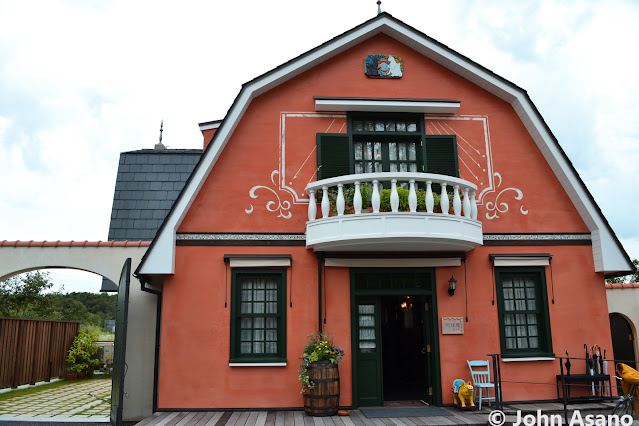 |
| The World Emporium at the Hill of Youth |
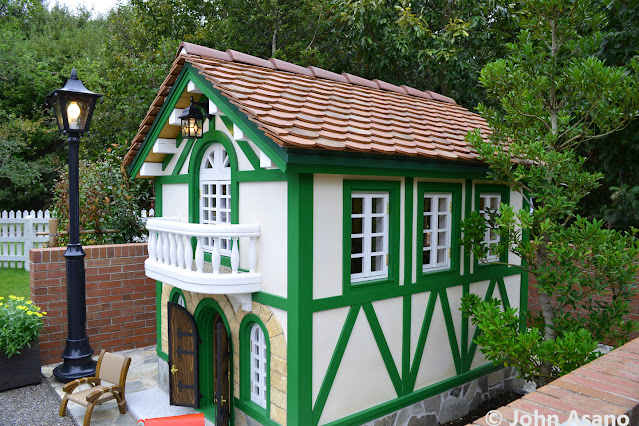 |
| The Cat Returns |
This large indoor area covering 9,600 square meters is home to
an exhibition room, a children’s playground, shops, restaurants, and a small
theatre. The idea of this area is to allow visitors to immerse themselves in the whimsical worlds of Ghibli and interact with famous scenes from the movies. You can see the Iron Giant from "Laputa: Castle in the Sky" (1986) and take a virtual train ride with Kaonashi from "Spirited Away" (2001).
 |
| Ghibli's Grand Warehouse |
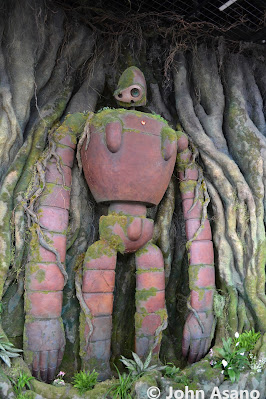 |
| The Iron Giant from Laputa |
Dondoko Forest is dedicated to the film "My Neighbor Totoro" (1988) with a 5-meter-tall wooden Totoro that visitors can actually climb inside.
 |
| Dondoko Forest |
 |
| A five-meter-tall wooden Totoro at Dondoko Forest |
The highlight of the Dondoko Forest area is walking through Satsuki and Mei’s house from My Neighbor Totoro, which was set in a rural landscape from the Showa period (1926-1989). The attention to detail in the house is amazing with period-specific furniture and items. There are actual real items from the 1950's here including newspapers and books. Part of the fun is looking around and discovering all the small details.
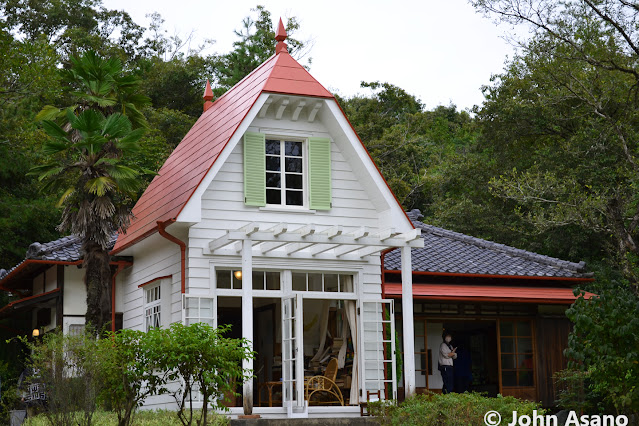 |
| Satsuki and Mei's House from My Neighbor Totoro |
 |
| Real Show Era items inside the house |
Mononoke’s Village will feature a real-life recreation of
Tatara-ba, the irontown depicted in the movie "Princess Mononoke" (1997). The beautiful scenery will
transport you back in time to the Muromachi period (1336-1573) of Japanese
history, where the movie is set.
 |
| Mononoke's Village (Photo: ©Studio Ghibli) |
The Valley of Witches draws inspiration from films that
feature protagonists with magic powers such as "Howl’s Moving Castle" (2004) and "Kiki’s Delivery Service" (1989).
It will be home to a real-life, 16-meter-tall replica of
Howl’s Moving Castle, including moving cannons resembling eyeballs.
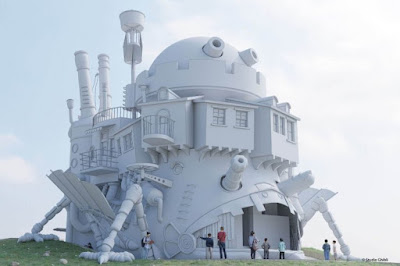 |
| Howl's Moving Castle (Photo: ©Studio Ghibli) |
Entry to the Expo Memorial Park is free but visitors will need to reserve tickets in order to enter each of the five areas.
Adult tickets for Ghibli's Grand Warehouse cost 2,000 yen on weekdays and 2,500 yen on weekends, while entry to the Hill of Youth and Dondoko Forest is 1,000 yen at all times. The fees for children are half-price.
This will be no ordinary theme park. You will not find rollercoasters or death-defying rides here, but simply a fantasy world, where you can feel part of your favourite Ghibli movie.
We talked about
the world of online travel writing along with a range of interesting topics
such as the coolest places to visit in Japan and whether Aussie space-rockers
The Church are the best band to ever come out of Australia. We also had a
chance to delve into some of my very early blog writing.
Today,
Jason has returned the favour by guest posting on Japan Australia to tell us
all about his wonderful new podcast, but before we get into all of that, let’s
find out a little about the man himself.
Jason was
born in Cranbrook, British Columbia, Canada, and grew up in the Okanagan
Valley. He received his BA from UBC in 1995 and moved to Japan, where he taught
English to students of all age groups. He also bartended, edited scientific
journals, officiated at hundreds of weddings, played bass in a KISS tribute
band, made amateur films, won his debut boxing match by TKO in the second
round, and traveled extensively in Japan, the rest of Asia and Europe. His
first book, “My Hand’s Tired & My Heart Aches: Letters from Japan
1995-2005,’ was published by Kalamalka Press in 2005.
 |
| A young Jason Emde in the middle |
Now, let’s hear from Jason about the inspiration for the Writers Read Their Early Sh*t podcast.
The idea for the Writers Read Their Early Sh*t podcast
first came to me while I was working on my Master’s Degree in Creative Writing
and happened to read a poem I wrote in elementary school about a tree. It
wasn’t much of a poem (“Emphatic!” reads my teacher’s only comment) and I
realized—or remembered—that all writers, famous and obscure, are probably sitting
on treasure troves of undeft early work, shitty first drafts, and undeveloped
and unsophisticated efforts, all of it stuck in a box in some closet or drawer.
I know I am: there are whole filing cabinets back in my hometown overflowing
with frothing journals, notebooks full of utterly pretentious waffle and
twaddle, stacks of mind-humpingly primitive poetry, and old letters full of
flatulent bombast and smut. Some of those early attempts and experiments, I
thought, might do at least three things when exposed to the air: provide a
charming autobiographical snapshot of the writer, with space for entering into
friendly relations with early ineptitude or artistic immaturity; encourage
considering everything an experiment,
and release some artistic pressure; and do their splendid to entertain. Early,
unripe work might provide an opportunity to confront a former version of
oneself, and maybe even forgive him or her, and it might delight and divert
other artists, no matter what stage of the game they’re at. That, in any case,
was the idea.
I launched the podcast in the
summer of 2021 and have interviewed—and vastly enjoyed the early sh*t of—poets
like Sarah Tsiang and James Tyler Russell, songwriters like David White and
Dave Antich (otherwise known as DJ Max in Tokyo, who provides all of the
podcast’s music), memoirists like Victoria Taylor, novelists like Adam Lewis
Schroeder, and travel writers like John Asano from Japan Australia. One
legendary episode featured my sister, Alison Emde, reading gems from her teenage
journals. The conversations so far have been freewheeling and funny and
unpretentious and intimate and moving, fueled by a love of language, a
fascination with craft, and a kind of broad-minded sympathy. There have also
been digressions into such things as literary pilgrimages, the best and worst
punctuation marks, macrame soap holders, secretly rooting for the monkey, how
The Church is (possibly) the best band Australia ever produced, why Japan is so
ace, and kabuki thunder-rockers KISS. I’m very much looking forward to talking
to more writers of all kinds (and all levels of success and achievement) and
exploring the occasionally unruly pleasures of their early, wet-behind-the-ears
work.
You can listen to all the episodes of the podcast at the Writers Read Their Early Sh*t podcast page, and give Jason and the podcast a follow on both Facebook and Instagram.
I have been studying Japanese for over 20 years now and in my time, I have discovered a lot of helpful books, amazing websites, and useful applications to make that studying process that little bit more fun and engaging.
The biggest challenge for me has always been trying to stay
motivated when being bogged down in all the books. I truly believe that one of
the best ways to stay motivated is by having fun with the language. After all,
you are more likely to remember something and retain it if you are enjoying the
study process while having a blast.
I am also a very competitive person and like to test myself
by setting goals, whether that be an upcoming Japanese test, or simply beating
my friends in Japanese.
One of the best resources that I have found for studying
Japanese is Nihongo Master, a fantastic Japanese learning website to help you
study Japanese in a fun and easy way.
.png)
The curriculum has been designed by native Japanese
instructors, so you know that you are getting the best Japanese possible. People new to the Japanese language, can start with the introductory lessons to learn the basics of reading, writing and speaking Japanese. There
are hundreds of lessons for all levels of language learners from beginners to
advanced.
The drills allow you to learn in the fastest way possible. As your studying accelerates new drills unlock. The learning is also
supported by periodic quizzes, a key to help challenge and motivate your
language acquisition.
One of the best features for me is the Kanji look-up
dictionary. This dictionary contains over 150,000 words and 13,000 kanji and is
a great tool to look up Japanese words, or English words to find the correct
Japanese equivalent.
Users can also print and customize handy character practice
sheets and study word lists.
